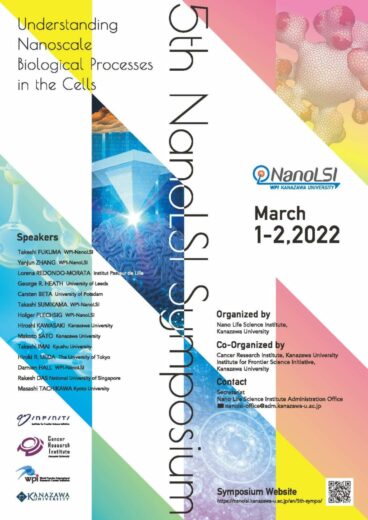5th NanoLSI Symposium will be held in online format on March 1-2, 2022
Nano Life Science Institute (WPI-NanoLSI) aims to acquire fundamental understanding of life phenomena on nanoscales.
The 5th NanoLSI Symposium is organized by Professor Alexander Mikhailov and Associate Professor Satoru Okuda from the Division of Computational Science in this institute. Its focus is on acquisition, processing and theoretical interpretation of experimental data in the research of dynamical nano-level processes in the cells. In the talks by invited speakers, current progress and the trends in the field will be presented and reviewed.
Viewing site is here!
5th NanoLSI Symposium Viewing Site – closed
Date
March 1 (Tue) to March 2 (Wed), 2022
Format
Online (Zoom)
Language
English
Registration
Closed. Thank you for your participation!
Fee
Free of charge
Flyer
Book of Abstracts
Program:
March 1, 2022 / Day 1 3:00 PM – 7:00 PM (JST)
| 3:00 pm – 3:10 pm | Opening remarks Takeshi Fukuma, Director of Nano Life Science Institute (WPI-NanoLSI), Kanazawa University |
| 3:15 pm – 5:15 pm |
Chair Noriyuki Kodera, Professor, WPI-NanoLSI
|
| 5:15 pm – 5:30 pm |
|
| 5:30 pm – 7:00 pm |
Chair Alexander Mikhailov, Professor, WPI-NanoLSI
|
March 2, 2022 / Day 2 3:00 PM – 6:45 PM (JST)
| 3:00 pm – 5:00 pm |
Chair Rikinari Hanayama, Professor, WPI-NanoLSI
|
| 5:00 pm – 5:15 pm |
|
| 5:15 pm – 6:45 pm |
Chair Satoru Okuda, Associate Professor, WPI-NanoLSI
|
| 6:45 pm – 7:00 pm | Closing remarks Alexander Mikhailov, Professor, Nano Life Science Institute, Kanazawa University |
Abstracts

Day 1 March 1, 2022
Session 1 3:15 pm – 5:15 pm (JST)
| 1. Takeshi FUKUMA | - | Visualizing Intracellular Nanostructures of Living Cells by Nanoendoscopy-AFM |
| 2. Yanjun ZHANG | - | Scanning Ion Conductance Microscopy-Based Nanoprobe for Biosensing at Single-Cell and Single-Molecule Level |
| 3. Lorena REDONDO-MORATA | - | Non-Equilibrium Dynamics and Nanomechanics of Lipid Membranes |
| 4. George R. HEATH | - | Localization Atomic Force Microscopy |
Session 2 5:30 pm – 7:00 pm (JST)
| 1. Carsten BETA | - | Insights into Amoeboid Motility, Combining Experiments, Data Analysis, and Modeling |
| 2. Takashi SUMIKAMA | - | Movies of Binding and Unbinding of Biomolecules and Analyses on Them |
| 3. Holger FLECHSIG | - | Simulation Atomic Force Microscopy |
Day 2 March 2, 2022
Session 3 3:00 pm – 5:00 pm (JST)
Session 4 5:15 pm – 6:45 pm (JST)
| 1. Damien HALL | - | Computational Modeling at the Nano Life Science Interface |
| 2. Rakesh DAS | - | Enzymatic Activity on Chromatin Organization – A Polymer Model Study |
| 3. Masashi TACHIKAWA | - | Physical Model Simulations for Understanding the Structures of Organelle Shapes |
 Takeshi FUKUMA
Takeshi FUKUMADirector/Professor, Nano Life Science Institute (WPI-NanoLSI), Kanazawa University
Visualizing Intracellular Nanostructures of Living Cells by Nanoendoscopy-AFM
Atomic force microscopy (AFM) is the only method that allows label-free imaging of nanoscale biomolecular dynamics and hence plays a critical role in solving biological questions that cannot be addressed only by the major bio-imaging tools (e.g., fluorescence and electron microscopy). However, such imaging is possible only for the systems either extracted from a cell or reconstructed on a solid substrate, and thus nanodynamics inside living cells largely remain inaccessible with the current nano-imaging techniques. Here we overcome this limitation by nanoendoscopy-AFM, where a specially designed long nanoprobe is inserted into a living cell and scanned in two- or three-dimension (2D/3D). We present direct imaging of the whole cell structure, 3D configurations of the actin fibers, and 2D nano-dynamics of the inner scaffold of the bottom plasma membrane. Importantly, our fluorometric assay reveals that such imaging does not give detectable changes in the cell viability. Unlike previous AFM techniques using ultrasonic waves or elastic responses, this method allows an AFM probe to directly access the target intra-cellular components so that we can exploit full range of AFM capabilities such as high-resolution imaging, nanomechanical mapping, and molecular recognition. These features should greatly expand the range of intra-cellular structures and properties observable in a live cell.References
- Penedo, M.; Miyazawa, K.; Okano, N.; Furusho, H.; Ichikawa, T.; Alam Mohammad, S.; Miyata,K.; Nakamura, C.; Fukuma, T., Visualizing intracellular nanostructures of living cells bynanoendoscopy-AFM. Science Advances 2021, 7 (52), eabj4990.
- Yurtsever, A.; Yoshida, T.; Badami Behjat, A.; Araki, Y.; Hanayama, R.; Fukuma, T., Structuraland mechanical characteristics of exosomes from osteosarcoma cells explored by 3D-atomicforce microscopy. Nanoscale 2021, 13 (13), 6661-6677.
- Penedo, M.; Shirokawa, T.; Alam, M. S.; Miyazawa, K.; Ichikawa, T.; Okano, N.; Furusho, H.;Nakamura, C.; Fukuma, T., Cell penetration efficiency analysis of different atomic force microscopy nanoneedles into living cells. Sci. Rep. 2021, 11 (1), 7756.
- Fukuma, T.; Garcia, R., Atomic- and Molecular-Resolution Mapping of Solid-Liquid Interfacesby 3D Atomic Force Microscopy. ACS Nano 2018, 12 (12), 11785-11797.
- Fukuma, T.; Ueda, Y.; Yoshioka, S.; Asakawa, H., Atomic-scale distribution of water moleculesat the mica-water interface visualized by three-dimensional scanning force microscopy. Phys.Rev. Lett. 2010, 104 (1), 016101.
 Yanjun ZHANG
Yanjun ZHANGAssociate Professor, Nano Life Science Institute (WPI-NanoLSI), Kanazawa University
Scanning Ion Conductance Microscopy-Based Nanoprobe for Biosensing at Single-Cell and Single-Molecule Level
Studies of our group focus on development of SICM and its applications to single-cell imaging. We have developed a non-contact single-cell mechanical probing method with hopping SICM nanoprobe. Moreover, we have developed a range of functionalized SICM-based nanoprobes for single cell and single molecule biosensing. Importantly, these functional nanoprobes can be integrated with SICM scanning and enable us to perform 3D mapping of extracellular and intracellular chemicals with higher spatial and temporal resolution. These new-developed SICM-based nanoprobes have been successfully used for pH and ROS biosensing of individual living cancer cells. We have also developed a new class of SICM-based nanoprobe FET sensors dubbed nexFET (nanopore extended Field Effect Transistor) that combines the advantages of non-contact SICM scanning, nanopore single molecule sensing, FET, and recognition chemistry. These SICM-based nexFETs enable label-free and real-time biosensing with heightened sensitivity and selectivity, and down to the single-molecule level.References
- Yanjun Zhang*, et al. High-Resolution Label-Free 3D Mapping of Extracellular pH of Single Living Cells. Nature Communications. 2019, 10:5610.
- Ren Ren, Yanjun Zhang*, et al. Nanopore Extended Field-Effect Transistor for Selective Single-Molecule Biosensing. Nature Communications. 2017, 8:586.
- Yanjun Zhang, et al. Spearhead Nanometric Field-Effect Transistor Sensors for Single-CellAnalysis. ACS Nano. 2016, 10 (3):3214–3221
 Lorena REDONDO-MORATA
Lorena REDONDO-MORATASenior Researcher Inserm/Institut Pasteur de Lille
Non-Equilibrium Dynamics and Nanomechanics of Lipid Membranes
In lipid membranes, the ultimate lipid phase coexistence to be fully understood are transient nanodomains, often (confusedly) referred to as lipid rafts [1]. Based on the current knowledge, microdomains in equilibrium are no longer considered suitable models for the biological structure that rafts represent. Multiscale spatiotemporal measurements of the membrane mechanical properties can help to experimentally address different scenarios where membrane micro- and nano-domain formation finds theoretical support. Atomic Force Microscopy (AFM)-based Force Spectroscopy can resolve coexistence of domains at concentrations where height differences at domain boundaries are not detectable [2], providing an ideal approach to investigate the mechanical properties of lipid bilayers at the nanoscale, their elastic constants [3] but also their plastic deformation and rupture [2]. High-Speed AFM imaging, in turn, provides us information about the dynamics of the domain boundaries. Non-equilibrium fluctuations by tuning membrane (local and global) environment actively controlling curvature, leaflet asymmetry, solid support topography and addition of external components would help complete the manifold where domain formation occurs. Here, we will discuss two examples of non-equilibrium membrane fluctuations. First, the in situ conversion of sphingomyelin to ceramide. Ceramide is produced in cells from sphingomyelin by means of the enzymatic activity of endogenous sphingomyelinase, impacting in the physical chemical properties of the membrane, inducing changes in the curvature, phase, segregation, and order. Last, we will discuss about the effect of Mag2 and PGLa, two antimicrobial peptides which, upon their interaction with biomembranes, they have been shown to gradually insert into the lipid bilayer as heterodimer clusters inducing several membrane perturbations as the alteration of lipid packing, pore openings and membrane disintegration.References
- F. M. Goñi, Chemistry and Physics of Lipids, 218 (2019), p. 34.
- L. Redondo-Morata et al., Langmuir, 28 (2012), p. 12851.
- L. Redondo-Morata, R. L. Sanford, O. S. Andersen et al, Biophysical Journal, 111 (2016), p. 363.
 George R. HEATH
George R. HEATHUniversity Academic Fellow, School of Physics & Astronomy, University of Leeds
Localization Atomic Force Microscopy
Understanding structural dynamics of biomolecules at the single-molecule level is vital to advancing our knowledge of molecular mechanisms. Currently, there are few techniques that can capture dynamics at the sub-nanometre scale and in physiologically relevant conditions. Atomic force microscopy (AFM) has the advantage of analysing unlabelled single molecules in physiological buffer and at ambient temperature and pressure, but its resolution can limit the assessment of conformational details of biomolecules. Here I will present localization AFM (LAFM), a technique developed to overcome current resolution limitations. By applying localization image reconstruction algorithms to peak positions in high-speed AFM and conventional AFM data, we increase the resolution beyond the limits set by the tip radius, and resolve single amino acid residues on soft protein surfaces in native and dynamic conditions. LAFM enables the calculation of high-resolution maps from either images of many molecules or many images of a single molecule acquired over time, facilitating single-molecule structural analysis. LAFM is a post-acquisition image reconstruction method that can be applied to any biomolecular AFM dataset.References
Heath G R, Kots E., Robertson J L, Lansky S, Khelashvili G, Weinstein H & Scheuring S. Localization Atomic Force Microscopy. Nature, 594, 385–390, (2021). Carsten BETA
Carsten BETAProfessor, Biological Physics, University of Potsdam
Insights into Amoeboid Motility, Combining Experiments, Data Analysis, and Modeling
The actin-driven motility of eukaryotic cells plays a central role in many biological functions such as wound healing, embryonic morphogenesis, and cancer metastasis. It is driven by coherent patterns of activity in the actin cytoskeleton. Here, we present experimental results demonstrating the rich diversity of wave patterns in the actin cortex of motile amoeboid cells. We show that actin waves mediate switches between different modes of motility, an amoeboid and a more persistent, keratocyte-like migratory mode, and may also trigger cell cycle-independent cytofission events. We analyzed our data using a Python-based toolbox that we have developed to quantify the shape dynamics of motile cells. Our experimental findings are rationalized in the framework of a noisy bistable reaction-diffusion model that mimics the evolution of cortical patterns and couples to a dynamic phase field to take the cell shape dynamics into account.References
- S. Flemming , F. Font, S. Alonso, and C. Beta, How cortical waves drive fission of motile cells, PNAS, 6337, Vol 117, No. 12 (2020).
- S. Alonso, M. Stange, C. Beta, Modeling random crawling, membrane deformation and intracellular polarity of motile amoeboid cells, PLoS ONE 13(8), e0201977 (2018).
- D Schindler, T Moldenhawer, M Stange, V Lepro, C Beta, M Holschneider, and W.Huisinga, Analysis of protrusion dynamics in amoeboid cell motility by means ofregularized contour flows, PLoS Computational Biology 17 (8), e1009268 (2021).
- E Moreno, S Flemming, F Font, M Holschneider, C Beta, S Alonso, Modeling cell crawlingstrategies with a bistable model: From amoeboid to fan-shaped cell motion, Physica D:Nonlinear Phenomena 412, 132591 (2020).
 Takashi SUMIKAMA
Takashi SUMIKAMAAssistant Professor, Nano Life Science Institute (WPI-NanoLSI), Kanazawa University/ PRESTO Researcher, Japan Science and Technology Agency
Movies of Binding and Unbinding of Biomolecules and Analyses on Them
Repeated binding and unbinding of biomolecules are the basis of cellular function at the nanoscale. For example, the binding and unbinding of actin-myosin complex is essential for muscle contraction (1), and that of ions and ion channels is the molecular basis of electrical conduction in the nervous system (2). Accordingly, one of the most effective ways to fundamentally understand biological functions is to capture movies filming such dynamics of molecules and analyze their trajectories. My first topic would be selective ion transport through the K+ channel, in which the movies of repetitive ion binding and unbinding were taken by the molecular dynamics (MD) simulation. The selectivity simulated was found to be more than two orders of magnitude smaller than expected but was comparable with the electrophysiological experiments (3). The second topic will be repetitive binding and unbinding of a toxin from a scorpion to the K+ channel filmed by the high-speed atomic force microscopy (HS-AFM). A theoretical analysis using the kinetic model concluded that the toxin binds to the channel almost solely via the induced-fit mechanism (4). The last topic would be a collaboration between the MD simulation and HS-AFM experiment to reveal the molecular mechanism of lipid digestion by phospholipase, in which the MD simulation reproduced the structure of phospholipase bound to the membrane observed in the HS-AFM.References
- Kodera, Yamamoto, Ishikawa, Ando, Video imaging of walking myosin V by high-speed atomicforce microscopy. Nature 468, 72 (2010).
- Sumikama, Oiki, Digitalized K+ Occupancy in the Nanocavity Holds and Releases Queues of K+ ina Channel. J. Am. Chem. Soc. 138, 10284 (2016).
- Mita, Sumikama (co-first), Iwamoto, Matsuki, Shigemi, Oiki, Conductance selectivity of Na+ acrossthe K+ channel via Na+ trapped in a tortuous trajectory. Proc. Natl. Acad. Sci. USA 118, e2017168118(2021).
- Sumino, Sumikama (co-first), Uchihashi, Oiki, High-speed AFM reveals accelerated binding ofagitoxin-2 to a K+ channel by induced fit. Sci. Adv. 5, eaax0495 (2019).
 Holger FLECHSIG
Holger FLECHSIGAssistant Professor, Nano Life Science Institute (WPI-NanoLSI), Kanazawa University
Simulation Atomic Force Microscopy
Observations of biomolecular structures and their conformational dynamics by atomic force microscopy (AFM) are restricted to changes of the molecular surface with limited resolution, preventing detailed understanding from experiments alone. We have developed simulation atomic force microscopy (sAFM) which allows to reconstruct 3D atomistic molecular structures from 2D topographic AFM images [1,2,3]. I present applications and demonstrate how the obtained full atomistic information advances the molecular understanding beyond topographic imaging.References
- R. Amyot, H. Flechsig. BioAFMviewer: an interactive interface for simulated AFM scanning of biomolecular structures and dynamics. PLoS Comput. Biol. 16, e1008444 (2020)
- R. Amyot, A. Marchesi, C.M. Franz, I. Casuso, H. Flechsig. Simulation atomic force microscopy for atomic reconstruction of biomolecular structures from resolution-limited experimental images. PLoS Comput. Biol. (2022)
- H. Flechsig. Simulation atomic force microscopy to predict correlated conformational dynamics in proteins from topographic imaging. bioRxiv doi:10.1101/2021.10.15.464530 (2021)
 Hiroshi KAWASAKI
Hiroshi KAWASAKIProfessor, Department of Medical Neuroscience, Graduate School of Medical Sciences, Kanazawa University
Mechanisms Underlying the Development and Evolution of the Mammalian Cerebral Cortex
The cerebral cortex of the brain has changed significantly during evolution. The cerebral cortex has become larger, and folds appeared on the surface of the cerebral cortex. Although these changes of the cerebral cortex are considered to be important for acquiring higher brain functions during evolution, the mechanisms underlying the expansion and folding of the cerebral cortex remain unclear. This is partially because the cerebral cortex of mice is relatively small and does not have cortical folds. Therefore, we have been utilizing ferrets, which have larger and folded cerebral cortex and established genetic manipulation techniques for the ferret cerebral cortex by combining in utero electroporation and the CRISPR/Cas9 system. Using our technique, we investigated the roles of sonic hedgehog (Shh) signaling in the development of the ferret cerebral cortex. We found that activation of Shh signaling resulted in additional folding in the ferret cerebral cortex. Consistently, suppression of Shh signaling by expressing Hhip-DeltaC22 inhibited cortical folding. Interestingly, we found that Shh signaling was more activated in the developing cerebral cortex of ferrets than that of mice, suggesting that Shh signaling is involved in the evolution of the cerebral cortex. Our technique for the ferret cerebral cortex should be useful for investigating the mechanisms underlying the development and evolution of the cerebral cortex.References
- eLife, 9, e54873, 2020
- Cerebral Cortex, 29, 4303-4311, 2019
- Cell Reports, 20, 2131-2143, 2017
- eLife, 6, e29285, 2017
 Makoto SATO
Makoto SATOProfessor, Mathematical Neuroscience Unit, Institute for Frontier Science Initiative, Kanazawa University
The Wave of Differentiation Orchestrates Neurogenesis and Column Formation in the Drosophila Brain
The wave of differentiation, ‘proneural wave’, sequentially generates neural stem cells on the surface of the Drosophila brain5. Combining mathematical modeling and molecular genetic analysis, we demonstrated that intracellular trafficking of Notch causes the non-linear dynamics of Notch signaling activity. As a result, Notch is activated twice along the proneural wave front. The first Notch activity negatively regulates the proneural wave propagation5, while the second peak controls the temporal transition of the neural stem cells, which ultimately specifies the fate of neurons1. Additionally, we showed that the proneural wave controls the formation of columnar structure, the morphological and functional unit of the brain2, 4. According to the radial unit hypothesis, neurons of the same lineage form a radial unit that contributes to column formation. However, the molecular mechanisms that provide a link between the neuronal lineage and column formation remain elusive. We demonstrated that Down syndrome cell adhesion molecule (Dscam) is temporally upreguated in new born neural stem cells, and is inherited to their daughter neurons3. The transient transcription of Dscam at the proneural wave front enables the expression of the same Dscam splice isoform within the same neuronal lineage, causing lineage-dependent axonal repulsion, and controls column formation. Thus, the proneural wave orchestrates neurogenesis through temporal Notch dynamics and column formation through temporal Dscam expression1, 3.References
- Intracellular trafficking of Notch orchestrates temporal dynamics of Notch activity in the flybrain. Wang, M., Han, X., Liu, C., Takayama, R., Yasugi, T., Ei, S., Nagayama, M., Tanaka, Y. andSato, M. Nature Communications 12, 2083 (2021).
- DWnt4 and DWnt10 regulate morphogenesis and arrangement of the columnar structures throughFz2/PCP signaling in the Drosophila brain. Han, X., Wang, M., Liu, C., Trush, O., Takayama,R., Akiyama, T., Naito, T., Tomomizu, T., Imamura, K. and Sato. M. Cell Reports 33, 108305(2020).
- Dscam1 establishes the columnar units through lineage-dependent repulsion between sisterneurons in the fly brain. Liu, C., Trush, O., Han, X., Wang, M., Takayama, R., Yasugi, T., Hayashi,T., Sato, M. Nature Communications 11, 4067 (2020).
- N-cadherin orchestrates self-organization of neurons within a columnar unit in the Drosophila medulla. Trush, O., Liu, C., Han, X., Nakai, Y., Takayama, R., Murakawa, H., Carrillo, J. A., Takechi, H., Hakeda-Suzuki, S., Suzuki T. and Sato, M. Journal of Neuroscience 39, 5861-5880 (2019).
- Notch-mediated lateral inhibition regulates proneural wave propagation when combined with EGF-mediated reaction diffusion. Sato, M., Yasugi, T., Minami, Y., Miura, T. and Nagayama, M.Proceedings of the National Academy of Sciences 113, E5153-E5162 (2016).
 Takeshi IMAI
Takeshi IMAIProfessor, Department of Developmental Neurophysiology, Graduate School of Medical Sciences, Kyushu University
Automatic Reconstruction of Neuronal Circuits with Super-Multicolor Labeling
All the brain functions originate from the neuronal circuits. It is, therefore, important to understand how neurons are interconnected in the brain. Stochastic multicolor labeling (e.g., Brainbow) is a powerful strategy to dissect and reconstruct densely labeled neuronal circuits. We previously developed a stochastic multicolor labeling method with enhanced expression levels that uses a tetracycline-operator system (Tetbow) (Sakaguchi et al., eLife, 2018). In Tetbow, three fluorescent protein (XFP) genes were expressed stochastically in neurons to generate various color hues. We optimized Tetbow for either plasmid or virus vector-mediated multicolor labeling. When combined with the tissue clearing method, SeeDB2, Tetbow was useful to visualize the three-dimensional architecture of individual neurons. For example, we were able to visualize the axonal projection patterns of individual mitral and tufted cells along several millimeters in the mouse olfactory system. However, the number of color hues generated by the combination of three XFPs was limited. Therefore, we still had to trace the multicolor-labeled neurites manually, which was the rate-limiting step in large-scale circuit reconstructions. Here we developed the “super-multicolor labeling” method with seven different XFPs, in which the number of possible color combinations was massively expanded. As trichromatic human eyes can only recognize the combination of red, green, and blue, we also developed a fully automated pipeline for the quantitative analysis of the color combinations generated by the super-multicolor labeling. Using this strategy, we have successfully reconstructed neuronal circuits in 3D “without manual neurite tracing”. Our strategy should facilitate fully automated light microscopy-based connectomics.References
- Ke M-T, Fujimoto S, Imai T. SeeDB: a simple and morphology-preserving optical clearingagent for neuronal circuit reconstruction. Nat Neurosci. 16:1154-1161. (2013)
- Ke MT, Nakai Y, Fujimoto S, Takayama R, Yoshida S, Kitajima TS, Sato M, Imai T. Super-Resolution Mapping of Neuronal Circuitry With an Index-Optimized Clearing Agent. CellRep. 14(11):2718-32.1 (2016)
- Sakaguchi R, Leiwe MN, Imai T. Bright multicolor labeling of neuronal circuits withfluorescent proteins and chemical tags. eLife e40350 (2018)
 Hiroki R. UEDA
Hiroki R. UEDAProfessor, Systems Pharmacology, Graduate School of Medicine, University of Tokyo
Team Leader, Laboratory for Synthetic Biology, Center for Biosystems Dynamics Research, RIKEN
Systems Biology of Mammalian Sleep/Wake Cycles: Phosphorylation Hypothesis of Sleep
The detailed molecular and cellular mechanisms underlying NREM sleep (slow-wave sleep) and REM sleep (paradoxical sleep) in mammals are still elusive. To address these challenges, we first constructed a mathematical model, Averaged Neuron Model (AN Model), which recapitulates the electrophysiological characteristics of the slow-wave sleep. Comprehensive bifurcation analysis predicted that a Ca2+-dependent hyperpolarization pathway may play a role in slow-wave sleep. To experimentally validate this prediction, we generate and analyze 26 KO mice, and found that impaired Ca2+-dependent K+ channels (Kcnn2 and Kcnn3), voltage-gated Ca2+ channels (Cacna1g and Cacna1h), or Ca2+/calmodulin-dependent kinases (Camk2a and Camk2b) decrease sleep duration, while impaired plasma membrane Ca2+ ATPase (Atp2b3) increases sleep duration. Genetical (Nr3a) and pharmacological intervention (PCP, MK-801 for Nr1/Nr2b) and whole-brain imaging validated that impaired NMDA receptors reduce sleep duration and directly increase the excitability of cells. Based on these results, we propose phoshporylation hypothesis of sleep that phosphorylation-dependent regulation of Ca2+-dependent hyperpolarization pathway underlies the regulation of sleep duration in mammals. We also recently developed a simplified mathematical model, Simplified Averaged Neuron Model (SAN Model), which uncover the important role of K+ leak channels in NREM sleep. In this talk, I will also describe how we identify essential genes (Chrm1 and Chrm3) in REM sleep regulation, and propose a plausible molecular definition of a paradoxical state of REM sleep.References
- Tatsuki et al. Neuron, 90(1): 70–85 (2016).
- Sunagawa et al, Cell Reports, 14(3):662-77 (2016).
- Susaki et al. Cell, 157(3): 726–39, (2014).
- Niwa et al, Cell report, 24, 2231-2247. e7 (2018).
- Ode and Ueda, Front. Psychol. 11, 575328 (2020).
 Damien HALL
Damien HALLAssistant Professor, Nano Life Science Institute (WPI-NanoLSI), Kanazawa University
Department of Applied Physics, Aalto University
Computational Modeling at the Nano Life Science Interface
In this talk I describe three different projects which simulate various aspects of cell behavior potentially realizable through atomic force microscopy (AFM) measurement. The first work describes a multiscale model of cell growth, division and epigenetic transfer of a polymer element able to replicate within the cytosol. The multiscale model pairs a stochastic particle model (to represent the cell body) and a large set of coupled ordinary differential equations (to describe the growth and partition of the polymer element). The second piece of work describes probabilistic methods for optimizing AFM-based feature assignment within live cell membranes. A diffusion-based description of the cell membrane components is coupled with an analytical model of the AFM tip raster scanning process in order to assess the effects of relative scanning rate and feature density on the assignment process. The third project is concerned with simulating force curve profiles associated with long AFM tip experiments that ‘penetrate’ into the cell interior. In this work the cell is modeled as a viscoelastic fluid with internal components assigned a set structure and spacing and modeled as breakable springs. This last piece of work (simulation of a force curve based on known cell structure) is analogous to solving the complementary forward aspect of a more difficult inverse problem (the assessment of cell structure based on analysis of a cell penetration force curve).References
- Ando, S., Matsuzawa, Y., Tsurui, H., Mizutani, T., Hall, D. and Kuroda, Y., 2021. Stochastic modelling of the effects of human-mobility restriction and viral infection characteristics on the spread of COVID-19. Scientific reports, 11(1), pp.1-10.
- Hall, D., 2020. On the nature of the optimal form of the holdase‐type chaperone stress response. FEBS letters, 594(1), pp.43-66.
- Wakayama, R., Uchiyama, S. and Hall, D., 2019. Ionic liquids and protein folding—old tricks for new solvents. Biophysical reviews, 11(2), pp.209-225.
 Rakesh DAS
Rakesh DASResearch Fellow, Mechanobiology Institute, National University of Singapore
Enzymatic Activity on Chromatin Organization – A Polymer Model Study
Spatial organization of chromatin plays a critical role in genome regulation [1]. Various types of affinity mediators and enzymes have been attributed to regulate spatial organization of chromatin from a thermodynamics perspective [2, 3]. However, at the mechanistic level, enzymes act in their unique ways. Here, we construct a polymer physics model following the mechanistic scheme of Topoisomerase-II [4], an enzyme resolving topological constraints of chromatin, and investigate its role on interphase chromatin organization. Our GPU-aided high-performance computer simulations demonstrate Topoisomerase-II’s ability to phase separate chromatin into eu- and heterochromatic regions with a characteristic wall-like organization of the euchromatic regions. Exploiting a mean-field framework, we argue that the ability of the euchromatic regions crossing each other due to enzymatic activity of Topoisomerase-II induces this phase separation. Motivated from a recent experimental observation on different structural states of the eu- and the heterochromatic units, we further extend our model to a bidisperse setting and show that the characteristic features of the enzymatic activity driven phase separation survives there. The existence of these characteristic features, even under the non-localized action of the enzyme, highlights the critical role of enzymatic activity in chromatin organization, and points out the importance of further experiments along this line, which may provide insights for the mechanisms of chromatin architecture change upon cell state modifications.References
- G. V. Shivashankar, Mechanical regulation of genome architecture and cell-fate decisions, Curr. Opin. Cell Biol. 56, 115 (2019).
- E. M. Hildebrand and J. Dekker, Mechanisms and functions of chromosome organization, Trends in Biochem. Sci. 45, 385 (2020).
- A. Agrawal, N. Ganai, S. Sengupta, and G. I. Menon, Nonequilibrium biophysical processesinfluence the large-scale architecture of the cell nucleus, Biophys. J. 118, 1 (2020).
- J. Roca, Topoisomerase II: a fitted mechanism for the chromatin landscape, Nucleic AcidsRes. 37, 721 (2009).
 Masashi TACHIKAWA
Masashi TACHIKAWAAssociate Professor, Institute for Frontier Life and Medical Sciences, Kyoto University
Physical Model Simulations for Understanding the Structures of Organelle Shapes
Eukaryotic cells have various functional units made of lipid-bilayer membrane, called organelles. Although their characteristic morphologies are thought to be closely related to their functions, the mechanisms to produce and maintain them remain largely unknown. We develop computational approaches to understand the mechanisms that govern the organelle structures. The size of organelles is up to 1 μm much larger than the molecular size. Continuum models are suitable for describing the organelle shapes. We employ a dynamically triangulated surface method to describe the tree dimensional shape of membrane. Two difficult points to understand from molecular biology study are the formation process of a complex organelle shape and the force balance to keep the shape steadily. Here we present two our recent studies on the formation of Golgi apparatus and the energy model for entire shape of inner and outer membranes of mitochondria. In the study of the Golgi apparatus, we mimic the Golgi apparatus formation process in mammalian cells and show the assembly of small membrane particles can self-organize into the characteristic Golgi shapes in a controlled physical condition. Latter study examine the detailed force balance on mitochondria membranes and discuss the relation between shape and these forces.References
- Membrane Simulation Models from Nanometer to Micrometer Scale. Noguchi H, J. Phys.Soc. Jpn., 78(4) 041007, 2009.
- Golgi apparatus self-organizes into the characteristic shape via postmitotic reassemblydynamics. Tachikawa M, Mochizuki A, PNAS 114(20) 5177-5182, 2017.


